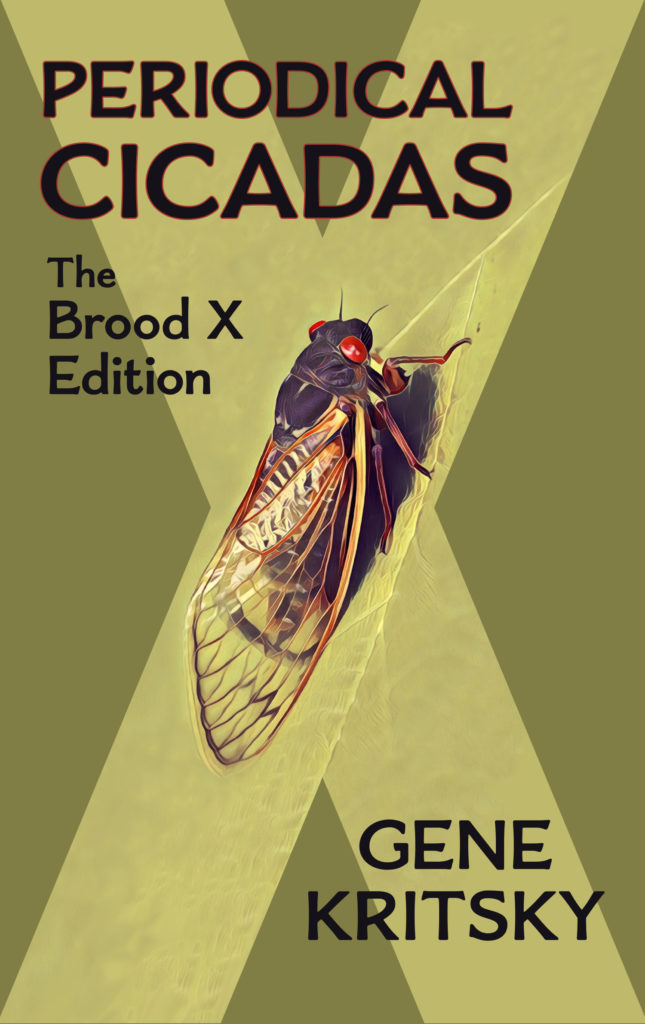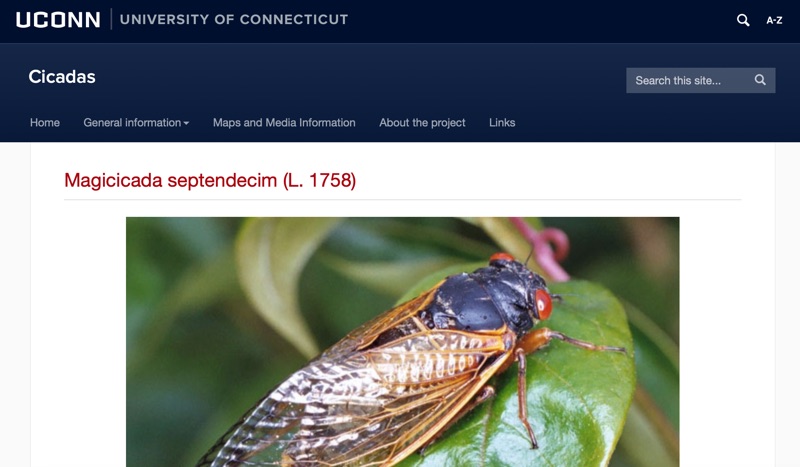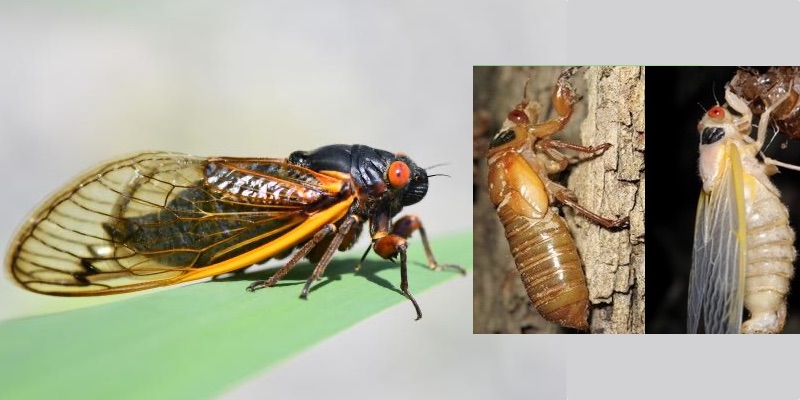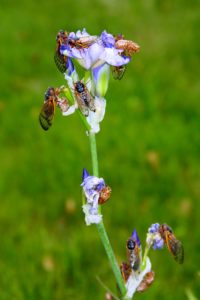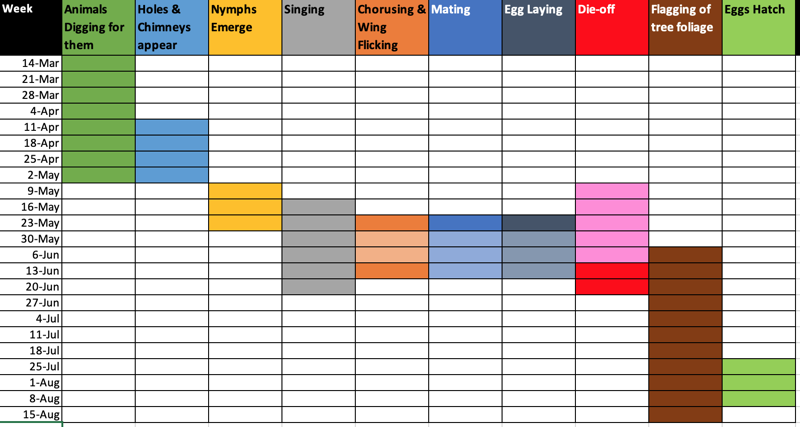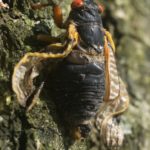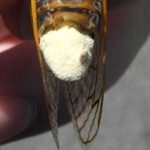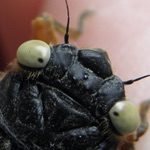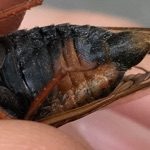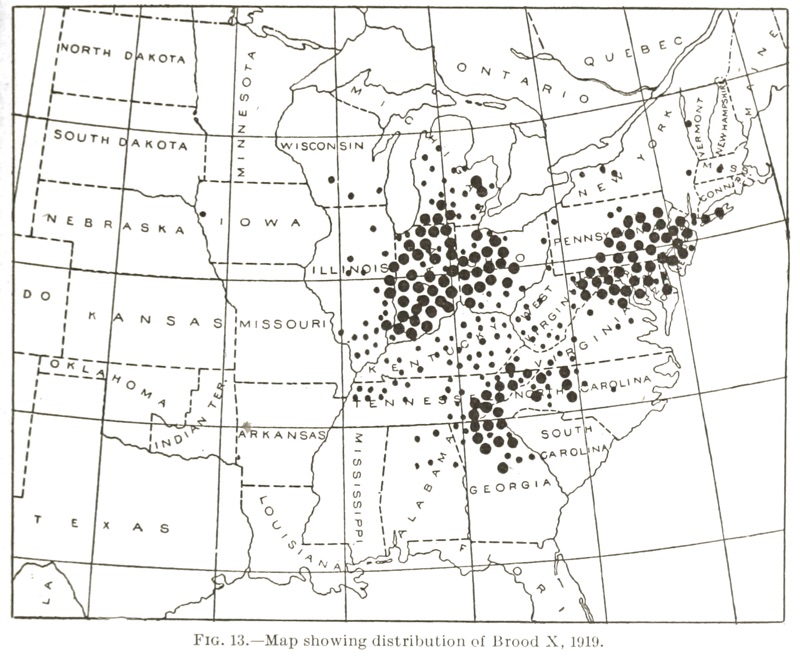Typically beginning in May and ending in late June. These cicadas will begin to emerge approximately when the soil 8" beneath the ground reaches 64 degrees Fahrenheit. A nice, warm rain will often trigger an emergence. Back in 2004, people began reporting emergences around May, 13th, but if the weather is warmer, it might start in late April. Update: in 2021, they started in Tennessee on 4/27.
Other tips: these cicadas will emerge after the trees have grown leaves, and, by my own observation, around the same time Iris flowers bloom:
Here’s my list from 2004. Green highlight means adults have emerged in 2021!
Delaware:
Delaware counties: Kent, New Castle, Sussex.
Delaware places: Newark, Wilmington.
Georgia:
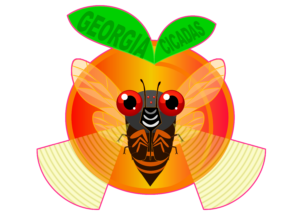
Georgia counties: Gilmer, Murray, Union, White, .
Georgia places: Blairsville, Blue Ridge, Chatsworth, Ellijay, Fort Mountain State Park, Norcross.
Illinois:

Illinois counties: Edgar, Clark, Cook, Crawford, Vermilion.
Illinois places: Marshall, Park Forest, University Park.
Indiana:

Indiana counties: Brown, Clark, Clay, Columbus, Crawford, Daviess, Dearborn, Dubois, Fountain, Gibson, Greene, Jackson, Jefferson, Jennings, Lawrence, Martin, Monroe, Montgomery, Morgan, Orange, Owen, Parke, Perry, Pike, Ripley, Spencer, Sullivan, Vanderburgh, Vigo, Warrick, Waveland, Washington.
Indiana places: Aurora, Bloomington, Brookville, Clinton Falls, Dillsboro, Fishers, French Lick, Henryville, Indianapolis, Lawrenceburg, Lexington, Martinsville, McCormick’s Creek State Park, Nashville, New Pelkin, North Vernon, Salem, Skiles Test Park, Spencer.
Kentucky:

Kentucky counties: Boone, Breckenridge, Bullitt, Carroll, Daviess, Gallatin, Grayson, Hardin, Henry, Jefferson, Livingston, La Rue, McLean, Muhlenberg, Nelson, Ohio, Oldham, Trimble.
Kentucky places: Big Bone Lick State Park, Covington, Dayton, Dry Ridge, Eastview, Florence, Ft. Thomas, Georgetown, Grand Rivers, Hebron, Highland Heights, Louisville, Newport, Villa Hills.
Maryland:

Maryland counties: Allegany, Anne Arundel, Baltimore, Carroll, Cecil, Frederick, Garrett, Harford, Howard, Montgomery, Prince Georges, Washington.
Maryland places: Abingdon, Annapolis, Aspen Hill, Baltimore (learn about the Baltimore Cicada Art project), Bel Air, Beltsville, Berwyn Heights, Bethesda, Bowie, Brooklandville, Brooklyn Park, Catonsville, Chevy Chase, Clarksville, Clinton, Colesville, College Park, Columbia, Cockeysville, Crofton, Cumberland, District Heights, Eldersburg, Elkridge, Elkton, Ellicott City, Fair Hill, Fallston, Forestville, Four Corners, Gaithersburg, Gambrills, Germantown, Glen Burnie, Glenelg, Greenbelt, Gwynn Oak, Hagerstown, Hanover, Havre De Grace, Hillcrest Heights, Hunt Valley, Hyattsville, Hydes, Jessup, Kensington, Landover Hills, Laurel, Linthicum, Loch Raven watershed, Lutherville, Odenton, Oella, Onley, Owings Mills, Pikesville, Potomac, Randallstown, Reisterstown, Riverdale, Rockville, Severna Park, Sharpsburg, Silver Spring, Takoma Park, Timonium, Towson, Travilah, Wheaton, Woodbine.
Want a FREE cicada book? In the DC area? Visit Lulu Florist, 4801 St. Elmo Ave., Bethesda, MD, and ask for a free copy of Cicada: Exotic Views by Davy Shian.
Michigan:
Michigan counties: Hillsdale, Washtenaw.
Michigan places: Ann Arbor, Canton, Quincy.
New Jersey:

New Jersey counties: Burlington, Hunterdon, Mercer, Middlesex, Salem, Somerset, Warren.
New Jersey places: Alexandria, Allerton, Annandale, Asbury, Belle Mead, Bethlehem Township, Berkeley Heights, Bloomsbury, Browns Mills, Carpentersville, Clinton, Clinton Township, Cranbury, Delaware Township, East Amwell Township, Flemington, Franklin Park, Franklin Township (Somerset), Franklin Township (Warren), Frenchtown, Greenwich Township, Grover’s Mill, Hampton, Harmony, Hillsborough Township, Holland Township, Hopewell Township, Kendall Park, Kingston, Kingwood Township, Lambertville, Lawrence, Lebanon, Merrill Creek Reservoir, Milford, Montgomery, Monmouth Junction, Morristown, Mt. Rose, Pennington, Perryville, Phillipsburg, Plainsboro Township, Pittstown, Pohatcong Township, Princeton, Princeton Junction, Princeton Meadows, Prallsville, Raritan Township, Raven Rock, Readington Township, Ringoes, Rosemont, Rocky Hill, Skillman, Sourland Mountain, South Brunswick Township, Stanton, Stewartsville, Stockton, Union Township (Hunterdon), Voorhees Corner, West Windsor Township.
There’s an abundance of large parks and natural areas around Princeton.
New York (Long Island):
New York counties: Suffolk (but extinct, or nearly so, but still look for them – Newsday article).
New York places: All on Long Island, but based on the 2004 emergence, they might be extinct. Some were seen in East Setauket, Connetquot River State Park, Ronkonkoma, Stony Brook. In 1987 they were seen in Shirley, Ronkonkoma, Bohemia, Connetquot River State Park, Oakdale, and Setauket.
In Long Island? Please read this article!.
North Carolina:
North Carolina counties: Buncombe, Cherokee, Surry, Wilkes.
North Carolina places: Apex, Elkin, Morganton, Murphy, Roaring River, Weaverville.
Ohio:

Ohio counties: Butler, Clermont, Defiance, Franklin, Greene, Hamilton, Logan, Montgomery.
Ohio places: Amelia, Anderson Twp, Battelle Darby Park, Batavia, Bellbrook, Camden, Centerville, Cincinnati, Columbus, Defiance, Delaware, Delhi Twp, Dublin, Fairfield, Galloway, Hamilton, Kettering, Lewisburg, Lockland, Miamisburg, Olmsted Falls, Oxford, Paint Creek State Park, Springfield, St. Bernard, West Carrollton, West Chester.
Pennsylvania:

Pennsylvania counties: Adams, Bedford, Berks, Bucks, Chester, Columbia, County, Cumberland, Dauphin, Delaware, Franklin, Fulton, Huntingdon, Lancaster, Lehigh, Luzerne, Lycoming, Mercer, Montgomery, Northampton, Perry, Schuylkill, Somerset, York.
Pennsylvania places:Archbald, Artemas, Bedford, Carroll Valley, Coopersburg, Dinosaur Rock, Downingtown, Erwinna, Gettysburg, Green Lane, Kintnersville, Lake Nockamixon, Lancaster, Lititz, Lumberville, Malvern, Mertztown, Metal Township, Mohnton, Mt Gretna, New Hope, Oaks, Oley, Perkasie, Perkiomenville, Phoenixville, Pipersville, Pittston, Plumstead Township, Point Pleasant, Quakertown, Red Lion, Roaring Spring, Solebury Township, Spring Mount, Stewartstown, Tinicum Township, Topton, Uhlerstown, Upper Black Eddy, Warwick Park, Williams Township.
Special note for folks in the Philly area: Is Philly Being Snubbed Again?.
Tennessee:
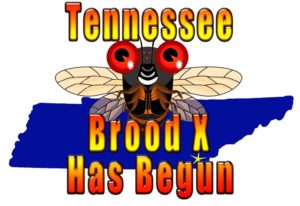
Tennessee counties: Blount, Greene, Hamblen, Hamilton, Jefferson, Knox, Polk, Roane, Sumner, Washtington, Wilson.
Tennessee places: Benton, Copperhill, Farragut, Fayetteville, Knoxville, Oak Ridge, Powell, Signal Mountain.
Virginia:

Virginia counties: Arlington, Clarke, County, Dulles Smithsonian National Aircraft and Space Museum, Fairfax, Fauquier, Frederick, Loudoun, Shenandoah, Warren, Winchester.
Virginia places: Alexandria, Annandale, Arlington, Ashburn, Centreville, Chantilly, Clearbrook, Del Ray, Doswell, Dunn Loring, Fairfax, Falls Church, Franconia, Gore, Hampton Roads, Haymarket, Herndon, Lorton, Lovettsville, Manassas, McLean, Merrifield, Oakton, Reston, Springfield, Sterling, Vienna, White Post, Winchester.
West Virginia:

West Virginia counties: Berkeley, Grant, Hampshire, Hardy, Jefferson, Mineral, Morgan.
West Virginia places: Inwood, Martinsburg, New Creek, Paw Paw.
Washington D.C.
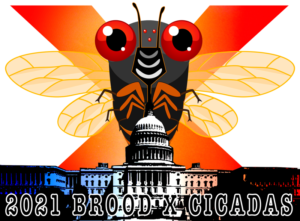
Washington D.C. places: Washington D.C.
Want a FREE cicada book? In the DC area? Visit Lulu Florist, 4801 St. Elmo Ave., Bethesda, MD, and ask for a free copy of Cicada: Exotic Views by Davy Shian.
This is an example of a typical cicada emergence. The exact dates will depend on the weather and density of the emergence in your location. Hot weather means an early start and quicker finish to the season — cool weather means a later start, and a protracted season.
If you’re planting trees, wait until July. If your yard doesn’t get cicadas by the first week of June, it’s probably safe to plant in June. It’s the egg-laying that does damage. Talk to an arborist or tree expert if you’re actually concerned. I can’t answer your questions.

